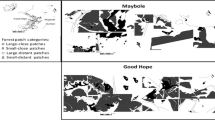Abstract
Determining the capacity of small forest remnants to support biodiversity is of critical importance, especially in the tropics where high rates of land conversion coincide with extraordinarily high species richness and endemism. Using fruit-baited traps, we conducted rapid evaluations in 1993 and 1994 of the forest butterfly diversity of seven small patches (3–30 ha) and a single remaining large patch (227 ha) of Costa Rican mid-elevation moist forest. Our results suggest that even recently isolated 20–30 ha fragments of primary forest retain surprisingly depauperate butterfly faunas relative to that supported by the 227 ha patch only 0.5–1.0 km away. If forest butterflies are an index of the diversity of small-bodied organisms in general, preservation of the latter may require unexpectedly large patches. In 1994 we also surveyed a 16 ha botanical garden, situated between and contiguous to both the 227 ha patch and an exceptionally species-rich 25 ha patch. In the garden, we discovered adults of many butterfly species associated with forest interior, suggesting that even heavily managed systems of largely exotic plants (such as agricultural systems) could be designed to serve as corridors for butterflies and perhaps some other groups of organisms. We discuss some implications for a planned restoration of biotic connections between lowland and montane forests in southern Costa Rica.
Similar content being viewed by others
References
Beckon, W.N. (1993) The effect on insularity on the diversity of land birds in the Fiji islands: implications for refuge design. Oecologia 94, 318–29.
Bierregaard, R.O.Jr., Lovejoy, T.F., Kapos, V, dos Santos, A.A. and Hutchings, R.W. (1992) The biological dynamics of tropical rainforest fragments. BioSci. 42, 859–66.
DeVries, P.J. (1987) The Butterflies of Costa Rica and Their Natural History. Princeton: Princeton University Press.
DeVries, P.J. (1991) The Butterflies of Jardin Botanico Wilson and Adjacent Forest. Mimeo.
Daily, G. and Ehrlich, P. (1994) Butterflies used as rapid assessment tool. Amigos Newsletter, Organization for Tropical Studies. 40, 12–14.
Ehrlich, P., Sparrow, H., Sisk, T. and Daily, G. (1994) Notes on butterfly distributions in southern Costa Rica (Lepidoptera: Papilionoidea). Trop. Lepidop. 5, 21–3.
Gadgil, M. and Guha, R. (1992) This Fissured Land: An Ecological History of India. Oxford: Oxford University Press.
Hodgson, J.G. (1993) Commonness and rarity in British butterflies. J. Appl. Ecol. 30, 407–27.
Holloway, J.D. (1980) Insect surveys — An approach to environmental monitoring. Atti XII Congr. Naz. Ital. Entomol., Roma: 239–61.
Janzen, D.H. (1973) Sweet samples of tropical foliage insects: effects of seasons, vegetation types, elevation, time of day, and insularity. Ecol. 54, 687–708.
Janzen, D.H. and Schoener, T.W. (1968) Differences in insect abundance and diversity between wetter and drier sites during a tropical dry season. Ecol. 49, 96–110.
Kaspari, M. (1994) Body size and microclimate use in neotropical granivorous ants. Oecologia (in press).
Kremen, C. (1992) Assessing the indicator properties of species assemblages for natural areas monitoring. Ecol. App. 2, 203–17.
Lovejoy, T.E., Bierregaard, R.O.Jr., Rylands, A.B., Malcolm, J.R., Quintela, C.E., Harper, L.H., Brown, K.S.Jr., Powell, A.H., Powell, G.V.N., Schubart, H.O.R. and Hays, M.B. (1986) Edge and other effects of isolation on Amazon forest fragments. In Conservation biology: the science of scarcity and diversity (M.E.Soule ed.) pp. 257–85. Sunderland, Ma: Sinauer Associates.
Newmark, W.D. (1991) Tropical forest fragmentation and the local extinction of understory birds in the Eastern Usambara Mountains, Tanzania. Conserv. Biol. 5, 67–78.
Noss, R.F. (1987) Corridors in real landscapes: a reply to Simberloff and Cox. Conserv. Biol. 1, 159–64.
Pulliam, R. (1988) Sources, sinks, and population regulation. Am. Nat. 132, 652–61.
Saunders, D.A. and Hobbs, R.J., eds (1991) The Role of Corridors. Chopping Norton, New South Wales, Australia: Surrey Beatty.
Scoble, M.J. (1992) The Lepidoptera: Form, Function and Diversity, Oxford: Oxford University Press.
Simberloff, D. and Cox, J. (1987) Consequences and costs of conservation corridors. Conserv. Biol. 1, 63–71.
Simberloff, D., Farr, J.A., Cox, J. and Mehlman, D.W. (1992) Movement corridors: conservation bargains or poor investments? Conserv. Biol. 6, 493–504.
Sisk, T. (1993a) Distribution and abundance of understory birds along disturbance gradients in Costa Rica: edge effects and community organization. Manuscript.
Sisk T. (1993b) Edge effects following tropical deforestation exert complex influences on habitat quality and biodiversity. Manuscript.
Skole, D. and Tucker, C. (1993) Tropical deforestation and habitat fragmentation in the Amazon: satellite data from 1978 to 1988. Science 260, 1905–10.
Smythe, N. (1978) The natural history of the Central American agouti (Dayprocta punctata). Smithsonian Contr. Zool., number 257.
Sokal, R.R. and Rohlf, F.J. (1981) Biometry, New York: Freeman.
Sparrow, H., Sisk, T., Ehrlich, P. and Murphy, D. (1994) Techniques and guidelines for monitoring Neotropical butterflies. Conserv. Biol. 8, 800–9.
Terborgh, J. (1976) Island biogeography and conservation: strategy and limitations. Science 193, 1029–30.
Wilson, E.O. (1987) The little things that run the world: the importance and conservation of invertebrates. Conserv. Biol. 1, 334–41.
Author information
Authors and Affiliations
Rights and permissions
About this article
Cite this article
Daily, G.C., Ehrlich, P.R. Preservation of biodiversity in small rainforest patches: rapid evaluations using butterfly trapping. Biodivers Conserv 4, 35–55 (1995). https://doi.org/10.1007/BF00115313
Received:
Revised:
Accepted:
Issue Date:
DOI: https://doi.org/10.1007/BF00115313




